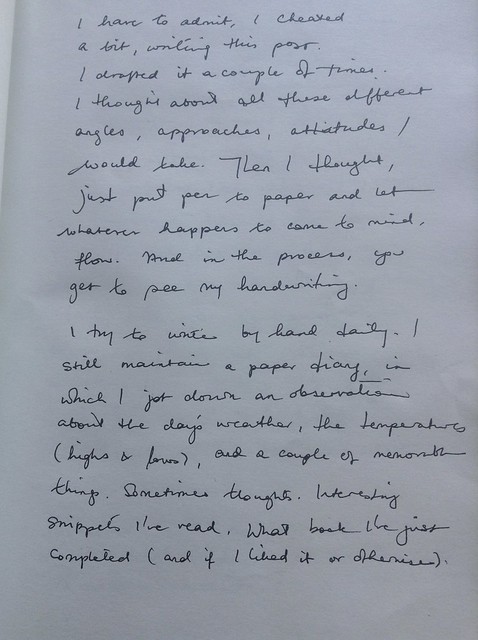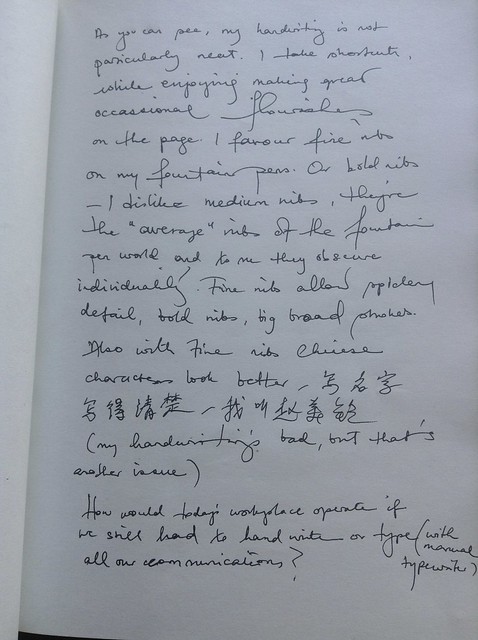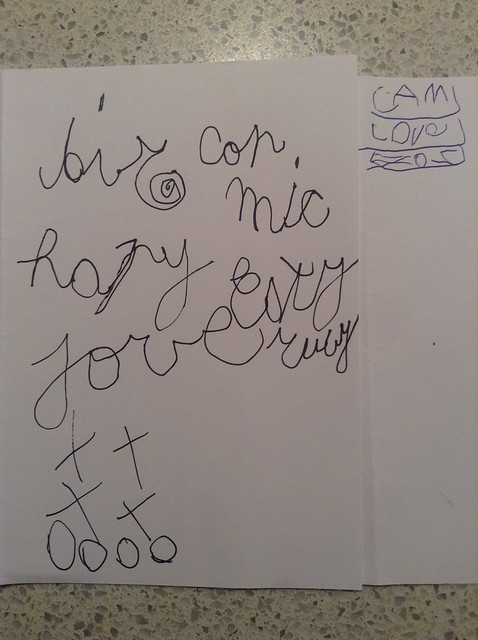This post was inspired by a chat I had with Mal Booth on Twitter on Sunday, and then by Mal’s posts on his blog.
My handwriting is not as neat as Mal’s. (Can you read my handwriting? Should I add a typewritten version?)
Currently reading Philip Hensher’s The Missing Ink, in which he laments the fact that handwriting is disappearing from our lives.
Near the beginning of the book, Hensher says:
About six months ago, I realized that I had no idea what the handwriting of a good friend of mine looked like. I had known him for over a decade, but somehow we had never communicated using handwritten notes. He had left messages for me, e-mailed me, sent text messages galore. But I don’t think I had ever had a letter from him written by hand, a postcard from his holidays, a reminder of something pushed through my letterbox. I had no idea whether his handwriting was bold or crabbed, sloping or upright, italic or rounded, elegant or slapdash.
The odd thing is this. It had never struck me as strange before, and there was no particular reason why it had suddenly come to mind. We could have gone on like this forever, hardly noticing that we had no need of handwriting any more.
Thinking on this, I do think I know what most of my colleagues’ handwriting looks like, but there are many many friends, other colleagues, and acquaintances whose handwriting is quite unknown to me. In many cases, I’m used to their writing styles, I know the particular turn of phrase an individual might use in an email, but it’s true, their handwriting is not something I look at at all regularly. We don’t generally receive letters, notes, or cards anymore, and certainly not handwritten ones. Isn’t it strange how this has just happened?
I read these passages in The Missing Ink, and was instantly transported back to my childhood:
Actually, I don’t think I have any memory of this initial introduction to the art of writing letters on paper with a pen. It was just there, hovering before the limits of conscious memory, like the day on which the letters in the book swam out of incoherence and into sensible words. That day must have existed, and must have been momentous. I just don’t remember it, and as far as I can tell from my memory, I’ve always been able to read and to write. When, as an adult, I went to Japan or to an Arabic-speaking country, and found myself functionally illiterate in the face of signs, it woke no deep memory in me of earliest childhood. It was just extremely strange.
But if I don’t have any memory of that first instruction in writing, I have a clear memory of what followed: instructions in refinements, suggestions of how to purify the forms of your handwriting. There was the element of aspiration, too. You longed to do ‘joined-up writing’, as we used to call the cursive hand when we were young. Instructed in print letters, I looked forward to the ability to join one letter to another as a mark of huge sophistication. Adult handwriting was unreadable, true, but perhaps that was its point. I saw the loops and impatient dashes of the adult hand as a secret and untrustworthy way of communicating that one day I would master. Unable to bear it any longer, I took a pen and covered a whole page of my school exercise book with grown-up writing, joined-up writing. There were no letters there to be read, still less words; just diagonal strokes linked each to the next in a bold series of gestures. That, I thought, was grown-up writing, if only it could be made to mean something, too.
There was, also, wanting to make your handwriting more like other people’s. Often, this started with a single letter or figure. In the second year at school, our form teacher had a way of writing a 7 in the European way, with a cross-bar. A world of glamour and sophistication hung on that cross-bar; it might as well have had a beret on, be smoking Gitanes in the maths cupboard.
I remember writing with pencils, then graduating to fountain pen (around age 9), and finally being allowed to graduate to ballpoint pens (at age 12). Oh, how adult it felt to be allowed to use a ballpoint pen. And figuring out how to sign my name! Nowadays my signature is about the only thing I am almost guaranteed to use a pen for, daily – my job requires me to sign things. What sort of signature will people be required to have in the future? How long will the requirement to sign things by hand remain?
Are children still being taught how to write? And if they are, what use will the skill be, if they end up mostly typing anyway? I mean, do children still handwrite their homework and essays now? Will their handwriting ever progress from the “childish”, so that they develop more adult, individual styles? Will they even be able to read handwriting?
My 5-year-old and 4-year-old nieces are currently learning how to write. Here are the cards they made for me and M for Easter.
Will they use a pen and paper very much in school, I wonder?
What does your handwriting look like, dear reader? I’d so love to see it! When was the last time you wrote something by hand?



3 Comments
Hi,
I was just thinking about doing a post about handwriting today, too. Synchronicity, eh?
I take a lot of notes by hand at work, and I know the handwriting of all my co-workers. (I’m the receptionist for my hubby’s boat repair shop.) Our customers sometimes leave us notes on their boats and I can’t help but save the silliest ones in a file folder.
Do you ever notice that you have different fonts with your handwriting? Oh, and how moods affect the size and shape, too?
Tui
visiting from #AtoZchallenge
Tui Snider’s Texas, Travel, Photos & Ideas
You asked! http://puddleish.wordpress.com/2013/04/12/12-04-13/ 🙂